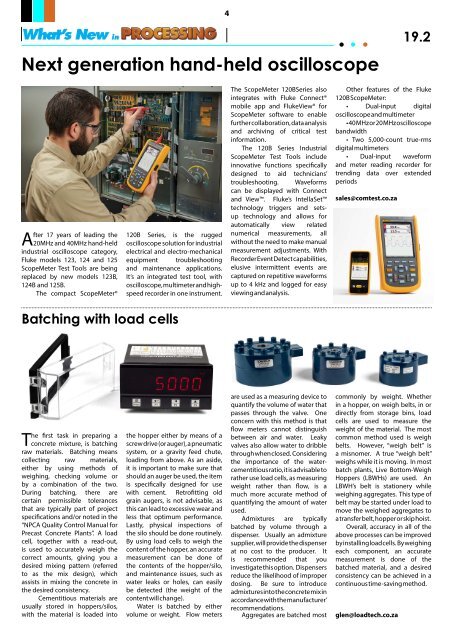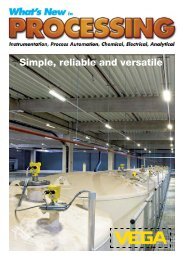WNIP Mar Apr 19.2 Digital
Create successful ePaper yourself
Turn your PDF publications into a flip-book with our unique Google optimized e-Paper software.
4<br />
Next generation hand-held oscilloscope<br />
<strong>19.2</strong><br />
After 17 years of leading the<br />
20MHz and 40MHz hand-held<br />
industrial oscilloscope category,<br />
Fluke models 123, 124 and 125<br />
ScopeMeter Test Tools are being<br />
replaced by new models 123B,<br />
124B and 125B.<br />
The compact ScopeMeter®<br />
120B Series, is the rugged<br />
oscilloscope solution for industrial<br />
electrical and electro-mechanical<br />
equipment troubleshooting<br />
and maintenance applications.<br />
It’s an integrated test tool, with<br />
oscilloscope, multimeter and highspeed<br />
recorder in one instrument.<br />
The ScopeMeter 120BSeries also<br />
integrates with Fluke Connect®<br />
mobile app and FlukeView® for<br />
ScopeMeter software to enable<br />
further collaboration, data analysis<br />
and archiving of critical test<br />
information.<br />
The 120B Series Industrial<br />
ScopeMeter Test Tools include<br />
innovative functions specifically<br />
designed to aid technicians’<br />
troubleshooting. Waveforms<br />
can be displayed with Connect<br />
and View. Fluke’s IntellaSet<br />
technology triggers and setsup<br />
technology and allows for<br />
automatically view related<br />
numerical measurements, all<br />
without the need to make manual<br />
measurement adjustments. With<br />
Recorder Event Detect capabilities,<br />
elusive intermittent events are<br />
captured on repetitive waveforms<br />
up to 4 kHz and logged for easy<br />
viewing and analysis.<br />
Other features of the Fluke<br />
120B ScopeMeter:<br />
• Dual-input digital<br />
oscilloscope and multimeter<br />
• 40 MHz or 20 MHz oscilloscope<br />
bandwidth<br />
• Two 5,000-count true-rms<br />
digital multimeters<br />
• Dual-input waveform<br />
and meter reading recorder for<br />
trending data over extended<br />
periods<br />
sales@comtest.co.za<br />
Batching with load cells<br />
The first task in preparing a<br />
concrete mixture, is batching<br />
raw materials. Batching means<br />
collecting raw materials,<br />
either by using methods of<br />
weighing, checking volume or<br />
by a combination of the two.<br />
During batching, there are<br />
certain permissible tolerances<br />
that are typically part of project<br />
specifications and/or noted in the<br />
“NPCA Quality Control Manual for<br />
Precast Concrete Plants”. A load<br />
cell, together with a read-out,<br />
is used to accurately weigh the<br />
correct amounts, giving you a<br />
desired mixing pattern (referred<br />
to as the mix design), which<br />
assists in mixing the concrete in<br />
the desired consistency.<br />
Cementitious materials are<br />
usually stored in hoppers/silos,<br />
with the material is loaded into<br />
the hopper either by means of a<br />
screw drive (or auger), a pneumatic<br />
system, or a gravity feed chute,<br />
loading from above. As an aside,<br />
it is important to make sure that<br />
should an auger be used, the item<br />
is specifically designed for use<br />
with cement. Retrofitting old<br />
grain augers, is not advisable, as<br />
this can lead to excessive wear and<br />
less that optimum performance.<br />
Lastly, physical inspections of<br />
the silo should be done routinely.<br />
By using load cells to weigh the<br />
content of the hopper, an accurate<br />
measurement can be done of<br />
the contents of the hopper/silo,<br />
and maintenance issues, such as<br />
water leaks or holes, can easily<br />
be detected (the weight of the<br />
content will change).<br />
Water is batched by either<br />
volume or weight. Flow meters<br />
are used as a measuring device to<br />
quantify the volume of water that<br />
passes through the valve. One<br />
concern with this method is that<br />
flow meters cannot distinguish<br />
between air and water. Leaky<br />
valves also allow water to dribble<br />
through when closed. Considering<br />
the importance of the watercementitious<br />
ratio, it is advisable to<br />
rather use load cells, as measuring<br />
weight rather than flow, is a<br />
much more accurate method of<br />
quantifying the amount of water<br />
used.<br />
Admixtures are typically<br />
batched by volume through a<br />
dispenser. Usually an admixture<br />
supplier, will provide the dispenser<br />
at no cost to the producer. It<br />
is recommended that you<br />
investigate this option. Dispensers<br />
reduce the likelihood of improper<br />
dosing. Be sure to introduce<br />
admixtures into the concrete mix in<br />
accordance with the manufacturer’<br />
recommendations.<br />
Aggregates are batched most<br />
commonly by weight. Whether<br />
in a hopper, on weigh belts, in or<br />
directly from storage bins, load<br />
cells are used to measure the<br />
weight of the material. The most<br />
common method used is weigh<br />
belts. However, “weigh belt” is<br />
a misnomer. A true “weigh belt”<br />
weighs while it is moving. In most<br />
batch plants, Live Bottom-Weigh<br />
Hoppers (LBWHs) are used. An<br />
LBWH’s belt is stationery while<br />
weighing aggregates. This type of<br />
belt may be started under load to<br />
move the weighed aggregates to<br />
a transfer belt, hopper or skip hoist.<br />
Overall, accuracy in all of the<br />
above processes can be improved<br />
by installing load cells. By weighing<br />
each component, an accurate<br />
measurement is done of the<br />
batched material, and a desired<br />
consistency can be achieved in a<br />
continuous time-saving method.<br />
glen@loadtech.co.za




